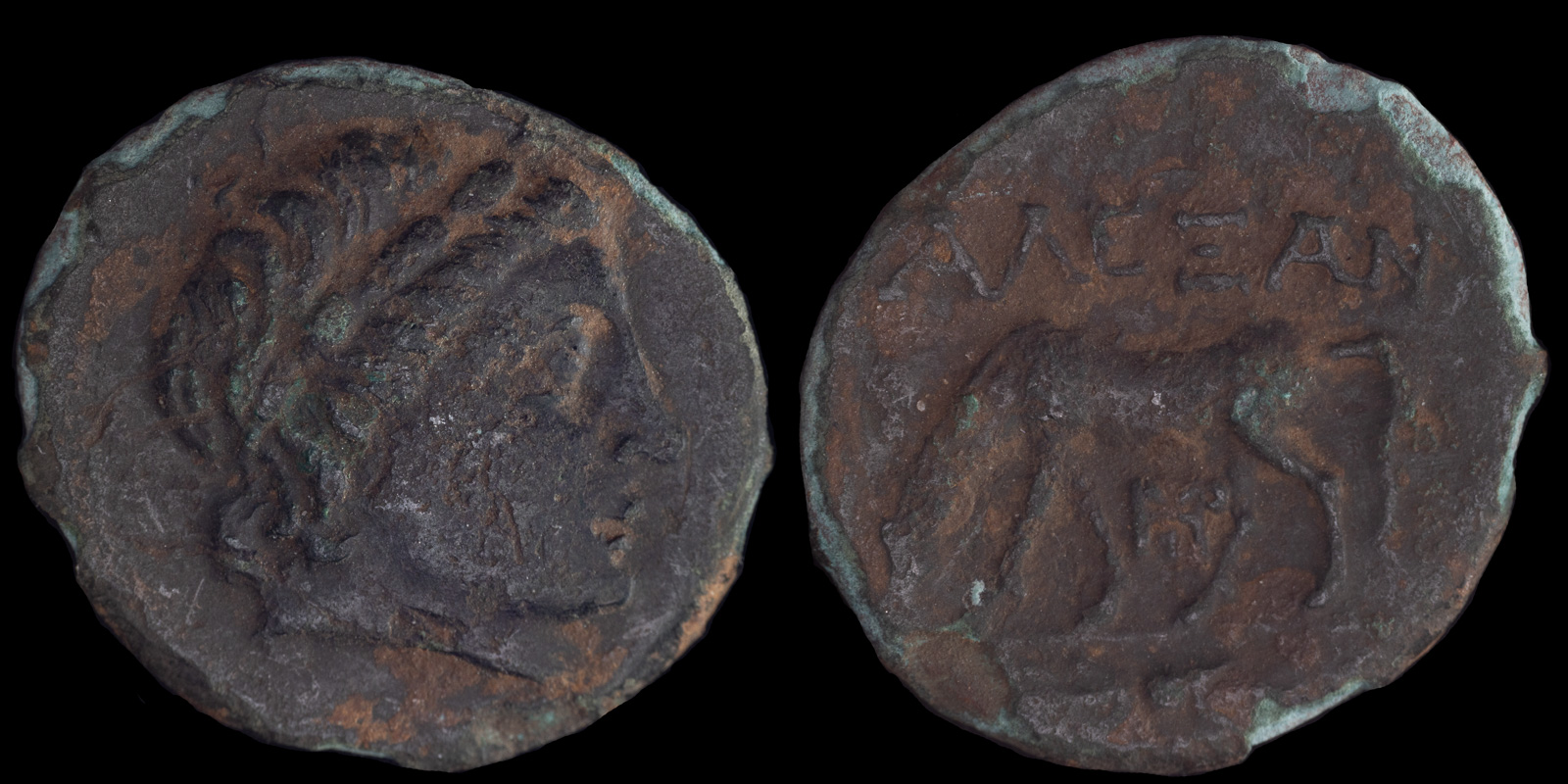
Troas, Alexandria Troas
281-261 BCE
AE 22mm 8.03g
Head of Apollo right
Horse feeding right, palm to right, grain ear in exergue ΑΛΕΞΑΝ-ΔΡΕΩΝ
Bellinger A28c
Alexandria Troas, also spelled Alexandreia or Troad, had an interesting formation. There the Greeks were in the Troad, just minding their own business, when along came Antigonos Monophthalmos.

Troas, Alexandreia
3rd century BCE
Æ 19mm, 3,18g
Obv: Laureate head of Apollo left.
Rev: AΛEΞAN, Horse grazing left; monogram below, thunderbolt in exergue.
SNG Copenhagen 73-4 var. (Thunderbolt)
Since all the rage back then was naming a city after yourself, Antigonos – being the baddest boy on the block – had to have one. The only problem was you needed actual people to create a city. Well, if you’re king, then you’re king. So, Antigonos grabbed a bunch of cities and forcibly moved them to his new metropolis, now called Antigoneia.

Troas, Alexandreia
3rd century BCE
Æ 12mm, 1,22g
Obv: Laureate head of Apollo left.
Rev: AΛEΞAN, Horse grazing left; monogram below.
SNG Copenhagen 73-4 var.(Thunderbolt)
Per Strabo, the unlucky customers were Neandria, Kolone, Hamaxitos, Skepsis, Kebren, and Achilleion/Achaion.

Troas, Alexandreia
3rd century BCE
Æ 18mm, 4,42g
Obv: Laureate head of Apollo left.
Rev: AΛEΞAN, Horse grazing left; monogram below, thunderbolt in exergue.
SNG Copenhagen 73-4 var. (Thunderbolt)
So, all was going well in the city until Antigonos was defeated and Lysimachos took over. Now, Lysimachos was a stickler for the rules and promptly brought out his rule book an naming ancient cities.
To all the personnel who erstwhile served under Alexander the Great, a word regarding the naming of new cities. If a ruler desires to name a city after his own self, he must first confirm whether a city has been named after Alexander the Great. If such a city has not been founded by the said ruler, then the first city he founds must bear Alexander‘s name. Subsequent cities may be named after the ruler as he deems fit.
But if a city is named inappropriately, according to these guidelines, and the territory is lost, the new ruler must rename the city to pay homage to Alexander. This city shall henceforth be counted as belonging to the new ruler, for he has honored Alexander, and the previous ruler must start anew and found another city, this time bearing the name of Alexander.
Clearly, Antigonos was in violation of the rules, so Lysimachos renamed the city to Alexandria (Troad) and was now per the guidelines. Of course, Lysimachos had earlier founded Lysimachia, but perhaps there was some other rule that has been lost to history.
Shortly afterwards, Alexandria Troad began minting these coins.
The dating of these coins has been debated, but a paper by Meadows suggests this particular one was minted very soon after the city’s creation. His logic is based on its similarity to some silver issues, but more particularly due to the mint symbol in the center and the fact that the horse faces right.
I’ve often wondered why the horse changed direction on coinage. In the earlier case of Philip II, the horse faced left until 348 BCE, after which it turned right. Perhaps the horses get tired after so many years going in the same direction? Maybe they get lost?
A bigger “smoking gun” is the late bronze coinage of Neandria, which depicts a nearly identical horse facing right along with the same mint mark. This would imply that the gap between the two issues was not long.
Meadows remarks that this brings up an interesting question. Could the city have been renamed during Antigonid times? Maybe someone sent Antigonos a copy of the rule book, and he voluntarily changed the name? Therefore, it seems that these coins either date from 301-281 BCE – roughly corresponding to Lysimachos‘ rule, or are slightly earlier – 306-281 BCE. Of course, that would imply continuity between these two rulers, who were known for disliking each other.
For example, Antigonos‘ son Demetrios I Poliorketes minted this coin, depicting him riding a horse over a lion – which was Lysimachos‘ namesake animal. This was minted right around the whole dispute with Lysimachos and friends killing Antigonos I Monophthalmos, then potentially renaming his city and all, and clearly Demetrios was bitter about the matter.
Strabo does note that when Lysimachos took over Antigoneia/Alexandria, he sent the citizens of Skepsis home. Eventually, those of Kolone and Hamaxitos also left. Perhaps at this time the Neandrians exerted some (small) dominance and began issuing coins similar to theirs? Given the changes, it would certainly seem that there would be some modification to the coinage. Therefore, my belief is these bronzes started in 301 BCE with Lysimachos, and probably continued until his defeat in 281 BCE. After this, control fell to the Seleukids, who must have had some issue with a right-facing horse.
Eventually under the Romans the city became among the most powerful and populous in the region.
Relevant Resources
Alexandria Troas founded by Antigonos I Monophthalmos from the cities of Neandria, Skepsis, Hamaxitos, Kolone, Kebren, Larissa-Ptolemais, and Achilleion.
Antigoneia renamed to Alexandria Troas by Lysimachos.
Antiochos III, desiring to meet Rome in battle, is detained by the cities of Alexandria Troas, Smyrna, and Lampsakos, which refused entreaties.